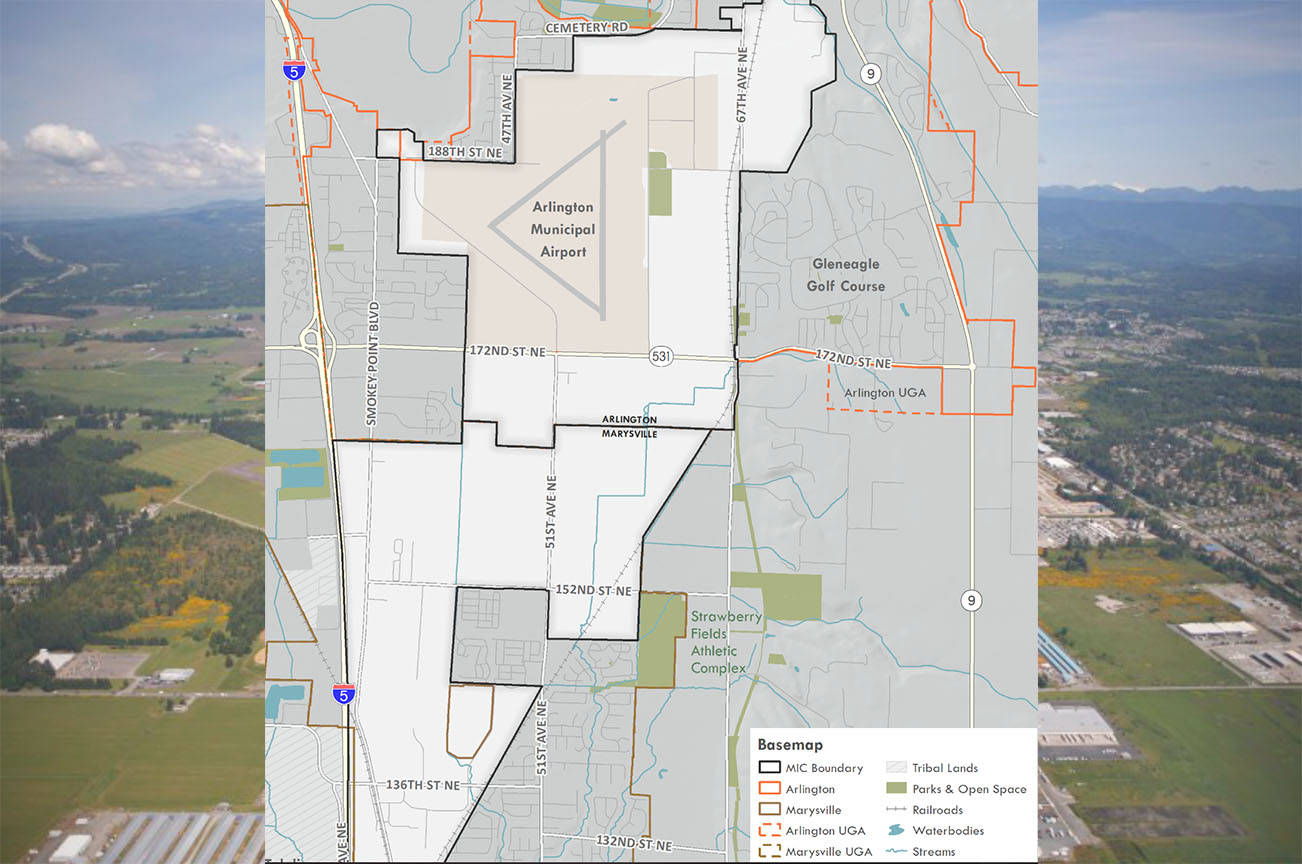ARLINGTON – The City Council set a public hearing Monday for the Arlington-Marysville Manufacturing Industrial Center (AMMIC) subarea plan and hope to adopt the area’s master blueprint for job creation that evening.
The hearing is 7 p.m. in the City Council Chambers, 110 E. 3rd St.
The plan is the result of months of shared planning between Arlington and Marysville to adopt policies and provisions in their jurisdictions for infrastructure that supports future industrial growth and development in the center.
The subarea plan is also a significant milestone in the cities’ pursuit to gain regional designation from the Puget Sound Regional Council for the MIC, which holds the potential to create 25,000 family wage jobs by 2040.
Total land area within the MIC boundaries includes 4,019 acres, of which 57 percent is in Arlington and 43 percent in Marysville, which includes the 737-acre Arlington Municipal Airport and land south of 172nd Street NE in the Smokey Point area. About 1,762 acres – 44 percent – consists of land ready to develop or redevelop. The state awarded both cities grants for the planning.
“This plan does exactly what we hoped it would do,” said Marc Hayes, Arlington community and economic development director.
Radhika Nair, subarea project manager with Berk Consulting, said the plan builds on work the city has already done to attract jobs and industrial manufacturing, and is “based on vision design ideas for how the MIC might develop.”
As an employment center, the MIC has many assets including suitable land for industrial activity, easy access to regional transportation routes, inclusion in the county’s aerospace industry cluster, general aviation airport and nearby affordable housing for the workforce.
The plan addresses five areas of goals and policies for land use, transportation, environment, economic development, and public facilities and infrastructure.
Nair emphasized, “The subarea plan does not require property owners to do anything.” Rather, it sets the framework and lays a road map for how the area develops.
While the public hearing isn’t until Monday, some residents from Airway Mobile Home Park came to the work session last week to talk about where housing fits in the subarea plan.
They are worried about the fate of the handful of mobile home parks like theirs existing in a behemoth of an industrial subarea devoid of housing.
“We live in Airway Park, and we’re concerned,” said one resident of the park at 6206 188th Street NE. “Every mobile home park may be exempt now, but what about several months down the road if someone buys it? I’ve been there three years, and kind of like the place, and a lot of the homes in the park can’t be moved.”
State law requires that in advance of a park closure or conversion of the park, a one-year notice must be given to tenants and managers in writing, and posted at park entrances. The state also offers a mobile home relocation assistance program that pays $7,500 toward the cost of moving a single-wide mobile home, or $12,000 for a multi-section home.
Hayes said the MIC abuts a few mobile homes, but they are considered a non-conforming use in planning documents.
“This is a long-range plan, it’s not like somebody is going to purchase the park,” Hayes said.
Park residents had also heard rumors that property around their park and near the Boys and Girls Club owned by Vulcan Inc., Paul Allen’s company has been sold to build condomiums.
Hayes said that was hearsay. In either case, Community Development would know about any plans by a property owner. “They would have to go through a rezone process. We have not been approached by anyone about any type of rezone of that property.”
Resident Neil Knutson said he hopes the mobile homes parks aren’t going away because a buyer wants to use the land in the MIC for something else.
“Older parks are true gems for seniors in the community,” he said, and affordable.
The subarea plan aligns with regional plans and complies with the Puget Sound Regional Council’s Regional Center Plans Checklist.
In October 2017, the cities were awarded a grant from the state Community Economic Revitalization Board to fund efforts to create the plan. The parties hired BERK Consulting to produce it.
BERK and the city used the web, an online community survey, workshops, stakeholder interviews, advisory committee and other public outreach means to craft a robust document built around the needs of both communities.
Based on an overview of the existing regional manufacturing landscape, site criteria and needs, the desired industry clusters include but are not limited to aerospace, advanced manufacturing, food processing, maritime, and wood products and mass timber, according to the plan.
“The report should be considered as a ‘living document’ to amend as the dynamics surrounding the MIC and the Puget Sound region change and adapt to the ever-changing economic environment,” Nair said.
The request to adopt the subarea plan also requires amending Arlington’s comprehensive land use plan.
With adoption of the Arlington plan, coupled later with Marysville’s approval of its portion, the cities in mid-January will apply jointly to the PRSC for regional designation as an MIC.
Official designation could come as early as June 2019.



